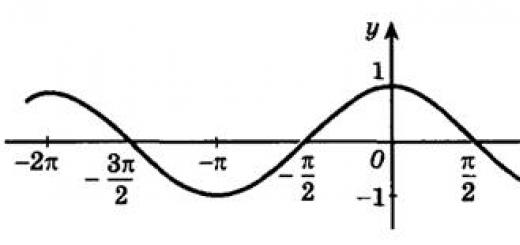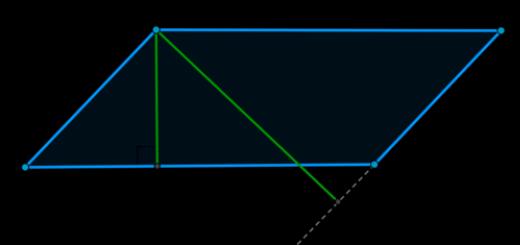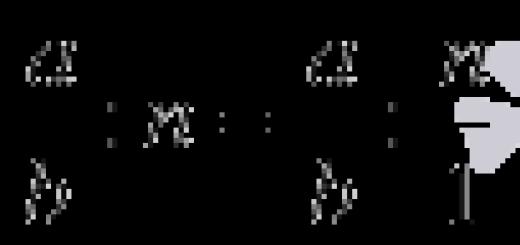even, if for all \(x\) from its domain is true: \(f(-x)=f(x)\) .
The graph of an even function is symmetrical about the \(y\) axis:
Example: the function \(f(x)=x^2+\cos x\) is even, because \(f(-x)=(-x)^2+\cos((-x))=x^2+\cos x=f(x)\).
\(\blacktriangleright\) The function \(f(x)\) is called odd, if for all \(x\) from its domain is true: \(f(-x)=-f(x)\) .
The graph of an odd function is symmetrical with respect to the origin:

Example: the function \(f(x)=x^3+x\) is odd because \(f(-x)=(-x)^3+(-x)=-x^3-x=-(x^3+x)=-f(x)\).
\(\blacktriangleright\) Functions that are neither even nor odd are called generic functions. Such a function can always be uniquely represented as the sum of an even and an odd function.
For example, the function \(f(x)=x^2-x\) is the sum of an even function \(f_1=x^2\) and an odd function \(f_2=-x\) .
\(\blacktriangleright\) Some properties:
1) The product and quotient of two functions of the same parity is an even function.
2) The product and quotient of two functions of different parity is an odd function.
3) The sum and difference of even functions is an even function.
4) The sum and difference of odd functions is an odd function.
5) If \(f(x)\) is an even function, then the equation \(f(x)=c \ (c\in \mathbb(R)\) ) has a unique root if and only if, when \(x =0\) .
6) If \(f(x)\) is an even or odd function, and the equation \(f(x)=0\) has a root \(x=b\) , then this equation will necessarily have a second root \(x =-b\) .
\(\blacktriangleright\) A function \(f(x)\) is called periodic on \(X\) if for some number \(T\ne 0\) we have \(f(x)=f(x+T) \) , where \(x, x+T\in X\) . The smallest \(T\) , for which this equality holds, is called the main (basic) period of the function.
A periodic function has any number of the form \(nT\) , where \(n\in \mathbb(Z)\) will also be a period.
Example: any trigonometric function is periodic;
for the functions \(f(x)=\sin x\) and \(f(x)=\cos x\) the principal period is \(2\pi\) , for the functions \(f(x)=\mathrm( tg)\,x\) and \(f(x)=\mathrm(ctg)\,x\) main period is \(\pi\) .

In order to plot a periodic function, you can plot its graph on any segment of length \(T\) (main period); then the graph of the entire function is completed by shifting the constructed part by an integer number of periods to the right and to the left:

\(\blacktriangleright\) The domain \(D(f)\) of the function \(f(x)\) is the set consisting of all values of the argument \(x\) for which the function makes sense (is defined).
Example: the function \(f(x)=\sqrt x+1\) has a domain of definition: \(x\in
Task 1 #6364
Task level: Equal to the Unified State Examination
For what values of the parameter \(a\) the equation
has a unique solution?
Note that since \(x^2\) and \(\cos x\) are even functions, if the equation has a root \(x_0\) , it will also have a root \(-x_0\) .
Indeed, let \(x_0\) be a root, that is, the equality \(2x_0^2+a\mathrm(tg)\,(\cos x_0)+a^2=0\) right. Substitute \(-x_0\) : \(2 (-x_0)^2+a\mathrm(tg)\,(\cos(-x_0))+a^2=2x_0^2+a\mathrm(tg)\,(\cos x_0)+a ^2=0\).
Thus, if \(x_0\ne 0\) , then the equation will already have at least two roots. Therefore, \(x_0=0\) . Then:
We got two parameter values \(a\) . Note that we have used the fact that \(x=0\) is exactly the root of the original equation. But we never used the fact that he is the only one. Therefore, it is necessary to substitute the resulting values of the parameter \(a\) into the original equation and check for which exactly \(a\) the root \(x=0\) will indeed be unique.
1) If \(a=0\) , then the equation will take the form \(2x^2=0\) . Obviously, this equation has only one root \(x=0\) . Therefore, the value \(a=0\) suits us.
2) If \(a=-\mathrm(tg)\,1\) , then the equation takes the form \ We rewrite the equation in the form \ Because \(-1\leqslant \cos x\leqslant 1\), then \(-\mathrm(tg)\,1\leqslant \mathrm(tg)\,(\cos x)\leqslant \mathrm(tg)\,1\). Therefore, the values of the right side of the equation (*) belong to the segment \([-\mathrm(tg)^2\,1; \mathrm(tg)^2\,1]\).
Since \(x^2\geqslant 0\) , then the left side of equation (*) is greater than or equal to \(0+ \mathrm(tg)^2\,1\) .
Thus, equality (*) can only hold when both sides of the equation are equal to \(\mathrm(tg)^2\,1\) . And this means that \[\begin(cases) 2x^2+\mathrm(tg)^2\,1=\mathrm(tg)^2\,1 \\ \mathrm(tg)\,1\cdot \mathrm(tg)\ ,(\cos x)=\mathrm(tg)^2\,1 \end(cases) \quad\Leftrightarrow\quad \begin(cases) x=0\\ \mathrm(tg)\,(\cos x) =\mathrm(tg)\,1 \end(cases)\quad\Leftrightarrow\quad x=0\] Therefore, the value \(a=-\mathrm(tg)\,1\) suits us.
Answer:
\(a\in \(-\mathrm(tg)\,1;0\)\)
Task 2 #3923
Task level: Equal to the Unified State Examination
Find all values of the parameter \(a\) , for each of which the graph of the function \
symmetrical about the origin.
If the graph of a function is symmetric with respect to the origin, then such a function is odd, that is, \(f(-x)=-f(x)\) is satisfied for any \(x\) from the function's domain. Thus, it is required to find those parameter values for which \(f(-x)=-f(x).\)
\[\begin(aligned) &3\mathrm(tg)\,\left(-\dfrac(ax)5\right)+2\sin \dfrac(8\pi a+3x)4= -\left(3\ mathrm(tg)\,\left(\dfrac(ax)5\right)+2\sin \dfrac(8\pi a-3x)4\right)\quad \Rightarrow\quad -3\mathrm(tg)\ ,\dfrac(ax)5+2\sin \dfrac(8\pi a+3x)4= -\left(3\mathrm(tg)\,\left(\dfrac(ax)5\right)+2\ sin \dfrac(8\pi a-3x)4\right) \quad \Rightarrow\\ \Rightarrow\quad &\sin \dfrac(8\pi a+3x)4+\sin \dfrac(8\pi a- 3x)4=0 \quad \Rightarrow \quad2\sin \dfrac12\left(\dfrac(8\pi a+3x)4+\dfrac(8\pi a-3x)4\right)\cdot \cos \dfrac12 \left(\dfrac(8\pi a+3x)4-\dfrac(8\pi a-3x)4\right)=0 \quad \Rightarrow\quad \sin (2\pi a)\cdot \cos \ frac34 x=0 \end(aligned)\]
The last equation must hold for all \(x\) from the domain \(f(x)\) , hence \(\sin(2\pi a)=0 \Rightarrow a=\dfrac n2, n\in\mathbb(Z)\).
Answer:
\(\dfrac n2, n\in\mathbb(Z)\)
Task 3 #3069
Task level: Equal to the Unified State Examination
Find all values of the parameter \(a\) , for each of which the equation \ has 4 solutions, where \(f\) is an even periodic function with period \(T=\dfrac(16)3\) defined on the entire real line , and \(f(x)=ax^2\) for \(0\leqslant x\leqslant \dfrac83.\)
(Task from subscribers)
Since \(f(x)\) is an even function, its graph is symmetrical with respect to the y-axis, therefore, when \(-\dfrac83\leqslant x\leqslant 0\)\(f(x)=ax^2\) . Thus, at \(-\dfrac83\leqslant x\leqslant \dfrac83\), and this is a segment of length \(\dfrac(16)3\) , the function \(f(x)=ax^2\) .
1) Let \(a>0\) . Then the graph of the function \(f(x)\) will look like this: 
Then, in order for the equation to have 4 solutions, it is necessary that the graph \(g(x)=|a+2|\cdot \sqrtx\) pass through the point \(A\) : 
Consequently, \[\dfrac(64)9a=|a+2|\cdot \sqrt8 \quad\Leftrightarrow\quad \left[\begin(gathered)\begin(aligned) &9(a+2)=32a\\ &9(a +2)=-32a \end(aligned) \end(gathered)\right. \quad\Leftrightarrow\quad \left[\begin(gathered)\begin(aligned) &a=\dfrac(18)(23)\\ &a=-\dfrac(18)(41) \end(aligned) \end( gathered)\right.\] Since \(a>0\) , then \(a=\dfrac(18)(23)\) is fine.
2) Let \(a<0\)
. Тогда картинка окажется симметричной относительно начала координат:
We need the graph \(g(x)\) to pass through the point \(B\) : \[\dfrac(64)9a=|a+2|\cdot \sqrt(-8) \quad\Leftrightarrow\quad \left[\begin(gathered)\begin(aligned) &a=\dfrac(18)(23 )\\ &a=-\dfrac(18)(41) \end(aligned) \end(gathered)\right.\] Since \(a<0\)
, то подходит \(a=-\dfrac{18}{41}\)
.
3) The case where \(a=0\) is not suitable, because then \(f(x)=0\) for all \(x\) , \(g(x)=2\sqrtx\) and The equation will only have 1 root.
Answer:
\(a\in \left\(-\dfrac(18)(41);\dfrac(18)(23)\right\)\)
Task 4 #3072
Task level: Equal to the Unified State Examination
Find all values \(a\) , for each of which the equation \
has at least one root.
(Task from subscribers)
We rewrite the equation in the form \
and consider two functions: \(g(x)=7\sqrt(2x^2+49)\) and \(f(x)=3|x-7a|-6|x|-a^2+7a\ ) .
The function \(g(x)\) is even, has a minimum point \(x=0\) (and \(g(0)=49\) ).
The function \(f(x)\) for \(x>0\) is decreasing, and for \(x<0\)
– возрастающей, следовательно, \(x=0\)
– точка максимума.
Indeed, for \(x>0\) the second module expands positively (\(|x|=x\) ), therefore, regardless of how the first module expands, \(f(x)\) will be equal to \( kx+A\) , where \(A\) is an expression from \(a\) , and \(k\) is equal to either \(-9\) or \(-3\) . For \(x<0\)
наоборот: второй модуль раскроется отрицательно и \(f(x)=kx+A\)
, где \(k\)
равно либо \(3\)
, либо \(9\)
.
Find the value \(f\) at the maximum point: \ 
In order for the equation to have at least one solution, it is necessary that the graphs of the functions \(f\) and \(g\) have at least one intersection point. Therefore, you need: \ \\]
Answer:
\(a\in \(-7\)\cup\)
Task 5 #3912
Task level: Equal to the Unified State Examination
Find all values of the parameter \(a\) , for each of which the equation \
has six different solutions.
Let's make the substitution \((\sqrt2)^(x^3-3x^2+4)=t\) , \(t>0\) . Then the equation will take the form \
We will gradually write out the conditions under which the original equation will have six solutions.
Note that the quadratic equation \((*)\) can have at most two solutions. Any cubic equation \(Ax^3+Bx^2+Cx+D=0\) can have no more than three solutions. Therefore, if the equation \((*)\) has two different solutions (positive!, since \(t\) must be greater than zero) \(t_1\) and \(t_2\) , then, having made the reverse substitution, we we get: \[\left[\begin(gathered)\begin(aligned) &(\sqrt2)^(x^3-3x^2+4)=t_1\\ &(\sqrt2)^(x^3-3x^2 +4)=t_2\end(aligned)\end(gathered)\right.\] Since any positive number can be represented as \(\sqrt2\) to some degree, for example, \(t_1=(\sqrt2)^(\log_(\sqrt2) t_1)\), then the first equation of the set will be rewritten in the form \
As we have already said, any cubic equation has no more than three solutions, therefore, each equation from the set will have no more than three solutions. This means that the whole set will have no more than six solutions.
This means that in order for the original equation to have six solutions, the quadratic equation \((*)\) must have two different solutions, and each resulting cubic equation (from the set) must have three different solutions (and not a single solution of one equation should coincide with which - or by the decision of the second!)
Obviously, if the quadratic equation \((*)\) has one solution, then we will not get six solutions for the original equation.
Thus, the solution plan becomes clear. Let's write out the conditions that must be met point by point.
1) For the equation \((*)\) to have two different solutions, its discriminant must be positive: \
2) We also need both roots to be positive (because \(t>0\) ). If the product of two roots is positive and their sum is positive, then the roots themselves will be positive. Therefore, you need: \[\begin(cases) 12-a>0\\-(a-10)>0\end(cases)\quad\Leftrightarrow\quad a<10\]
Thus, we have already provided ourselves with two distinct positive roots \(t_1\) and \(t_2\) .
3)
Let's look at this equation \
For what \(t\) will it have three different solutions? Thus, we have determined that both roots of the equation \((*)\) must lie in the interval \((1;4)\) . How to write this condition? had four distinct non-zero roots, representing together with \(x=0\) an arithmetic progression. Note that the function \(y=25x^4+25(a-1)x^2-4(a-7)\) is even, so if \(x_0\) is the root of the equation \((*)\ ) , then \(-x_0\) will also be its root. Then it is necessary that the roots of this equation be numbers ordered in ascending order: \(-2d, -d, d, 2d\) (then \(d>0\) ). It is then that these five numbers will form an arithmetic progression (with the difference \(d\) ). For these roots to be the numbers \(-2d, -d, d, 2d\) , it is necessary that the numbers \(d^(\,2), 4d^(\,2)\) be the roots of the equation \(25t^2 +25(a-1)t-4(a-7)=0\) . Then by Vieta's theorem: We rewrite the equation in the form \
and consider two functions: \(g(x)=20a-a^2-2^(x^2+2)\) and \(f(x)=13|x|-2|5x+12a|\) . In order for the equation to have at least one solution, it is necessary that the graphs of the functions \(f\) and \(g\) have at least one intersection point. Therefore, you need: \
Solving this set of systems, we get the answer: \\]
Answer: \(a\in \(-2\)\cup\) Which to one degree or another were familiar to you. It was also noted there that the stock of function properties will be gradually replenished. Two new properties will be discussed in this section. Definition 1. The function y \u003d f (x), x є X, is called even if for any value x from the set X the equality f (-x) \u003d f (x) is true. Definition 2. The function y \u003d f (x), x є X, is called odd if for any value x from the set X the equality f (-x) \u003d -f (x) is true. Prove that y = x 4 is an even function. Solution. We have: f (x) \u003d x 4, f (-x) \u003d (-x) 4. But (-x) 4 = x 4 . Hence, for any x, the equality f (-x) = f (x), i.e. the function is even. Similarly, it can be proved that the functions y - x 2, y \u003d x 6, y - x 8 are even. Prove that y = x 3 is an odd function. Solution. We have: f (x) \u003d x 3, f (-x) \u003d (-x) 3. But (-x) 3 = -x 3 . Hence, for any x, the equality f (-x) \u003d -f (x), i.e. the function is odd. Similarly, it can be proved that the functions y \u003d x, y \u003d x 5, y \u003d x 7 are odd. You and I have repeatedly convinced ourselves that new terms in mathematics most often have an “earthly” origin, i.e. they can be explained in some way. This is the case for both even and odd functions. See: y - x 3, y \u003d x 5, y \u003d x 7 are odd functions, while y \u003d x 2, y \u003d x 4, y \u003d x 6 are even functions. And in general, for any function of the form y \u003d x "(below we will specifically study these functions), where n is a natural number, we can conclude: if n is an odd number, then the function y \u003d x" is odd; if n is an even number, then the function y = xn is even. There are also functions that are neither even nor odd. Such, for example, is the function y \u003d 2x + 3. Indeed, f (1) \u003d 5, and f (-1) \u003d 1. As you can see, here Hence, neither the identity f (-x) \u003d f ( x), nor the identity f(-x) = -f(x). So, a function can be even, odd, or neither. The study of the question of whether a given function is even or odd is usually called the study of the function for parity. Definitions 1 and 2 deal with the values of the function at the points x and -x. This assumes that the function is defined both at the point x and at the point -x. This means that the point -x belongs to the domain of the function at the same time as the point x. If a numerical set X together with each of its elements x contains the opposite element -x, then X is called a symmetric set. Let's say (-2, 2), [-5, 5], (-oo, +oo) are symmetric sets, while ; (∞;∞) are symmetric sets, and , [–5;4] are nonsymmetric. - Do even functions have a domain of definition - a symmetric set? The odd ones? Slide
Algorithm for examining a function for parity 1. Determine whether the domain of the function is symmetrical. If not, then the function is neither even nor odd. If yes, then go to step 2 of the algorithm. 2. Write an expression for f(–X). 3. Compare f(–X).and f(X): Examples:
Investigate the function for parity a) at= x 5 +; b) at= ; in) at= . Solution. a) h (x) \u003d x 5 +, 1) D(h) = (–∞; 0) U (0; +∞), symmetric set. 2) h (- x) \u003d (-x) 5 + - x5 - \u003d - (x 5 +), 3) h (- x) \u003d - h (x) \u003d\u003e function h(x)= x 5 + odd. b) y =, at = f(X), D(f) = (–∞; –9)? (–9; +∞), asymmetric set, so the function is neither even nor odd. in) f(X) = , y = f(x), 1) D( f) = (–∞; 3] ≠ ; b) (∞; –2), (–4; 4]? Option 2 1. Is the given set symmetric: a) [–2;2]; b) (∞; 0], (0; 7) ? a) y \u003d x 2 (2x - x 3), b) y \u003d Mutual check on slide. 6. Homework: №11.11, 11.21,11.22; Proof of the geometric meaning of the parity property. *** (Assignment of the USE option). 1. The odd function y \u003d f (x) is defined on the entire real line. For any non-negative value of the variable x, the value of this function coincides with the value of the function g( X)
= X(X + 1)(X + 3)(X– 7). Find the value of the function h( X) = at X = 3. 7. Summing up
Consider the function \(f(x)=x^3-3x^2+4\) .
Can be multiplied: \
Therefore, its zeros are: \(x=-1;2\) .
If we find the derivative \(f"(x)=3x^2-6x\) , then we get two extreme points \(x_(max)=0, x_(min)=2\) .
Therefore, the graph looks like this: 
We see that any horizontal line \(y=k\) , where \(0
Thus, you need: \[\begin(cases) 0<\log_{\sqrt2}t_1<4\\ 0<\log_{\sqrt2}t_2<4\end{cases}\qquad (**)\]
Let's also note right away that if the numbers \(t_1\) and \(t_2\) are different, then the numbers \(\log_(\sqrt2)t_1\) and \(\log_(\sqrt2)t_2\) will be different, so the equations \(x^3-3x^2+4=\log_(\sqrt2) t_1\) and \(x^3-3x^2+4=\log_(\sqrt2) t_2\) will have different roots.
The \((**)\) system can be rewritten like this: \[\begin(cases) 1
We will not explicitly write out the roots.
Consider the function \(g(t)=t^2+(a-10)t+12-a\) . Its graph is a parabola with upward branches, which has two points of intersection with the abscissa axis (we wrote this condition in paragraph 1)). How should its graph look like so that the points of intersection with the abscissa axis are in the interval \((1;4)\) ? So: 
Firstly, the values \(g(1)\) and \(g(4)\) of the function at the points \(1\) and \(4\) must be positive, and secondly, the vertex of the parabola \(t_0\ ) must also be in the interval \((1;4)\) . Therefore, the system can be written: \[\begin(cases) 1+a-10+12-a>0\\ 4^2+(a-10)\cdot 4+12-a>0\\ 1<\dfrac{-(a-10)}2<4\end{cases}\quad\Leftrightarrow\quad 4
The function \(g(x)\) has a maximum point \(x=0\) (and \(g_(\text(top))=g(0)=-a^2+20a-4\)):
\(g"(x)=-2^(x^2+2)\cdot \ln 2\cdot 2x\). Zero derivative: \(x=0\) . For \(x<0\)
имеем: \(g">0\) , for \(x>0\) : \(g"<0\)
.
The function \(f(x)\) for \(x>0\) is increasing, and for \(x<0\)
– убывающей, следовательно, \(x=0\)
– точка минимума.
Indeed, for \(x>0\) the first module expands positively (\(|x|=x\) ), therefore, regardless of how the second module expands, \(f(x)\) will be equal to \( kx+A\) , where \(A\) is an expression from \(a\) , and \(k\) is either \(13-10=3\) or \(13+10=23\) . For \(x<0\)
наоборот: первый модуль раскроется отрицательно и \(f(x)=kx+A\)
, где \(k\)
равно либо \(-3\)
, либо \(-23\)
.
Let's find the value \(f\) at the minimum point: \

- If D( f) is an asymmetric set, then what is the function?
– Thus, if the function at = f(X) is even or odd, then its domain of definition is D( f) is a symmetric set. But is the converse true, if the domain of a function is a symmetric set, then it is even or odd?
- So the presence of a symmetric set of the domain of definition is a necessary condition, but not a sufficient one.
– So how can we investigate the function for parity? Let's try to write an algorithm.
a); b) y \u003d x (5 - x 2).2. Examine the function for parity:
3. In fig. plotted at = f(X), for all X, satisfying the condition X?
0.
Plot the Function at = f(X), if at = f(X) is an even function. 
3. In fig. plotted at = f(X), for all x satisfying x? 0.
Plot the Function at = f(X), if at = f(X) is an odd function. 










